The Stained Glass Cycle at Déols
Between 1929 and 1932 the Parisian atelier Mauméjean Frères created a vivid sequence of stained-glass windows for the church of Notre-Dame, Déols. The cycle traces key moments in the lives of the Virgin Mary and Christ, from the Nativity and Annunciation through the Visitation and the miracle at Cana, and finally to the Crucifixion, Resurrection, and the heavenly Coronation of the Virgin.
The windows combine medievalising architectural forms with the bright, modern palette of the interwar period. Strong black lines, faceted drapery, and radiant beams of gold unify the cycle, while intense blues, reds, and purples reflect the workshop’s distinctive colour language. Despite stylistic variations, the ensemble forms a coherent liturgical and artistic programme.
The Windows

The earliest window of the cycle sets the tone for the programme. Mary and Joseph attend the newborn Christ in a humble stable illuminated by a dramatic burst of golden light from above. The radiant beams, vibrant blues, and sharply drawn drapery show the workshop’s fully developed late-1920s style. Angels stand in adoration, while the ox and ass are rendered with warm, expressive detail.
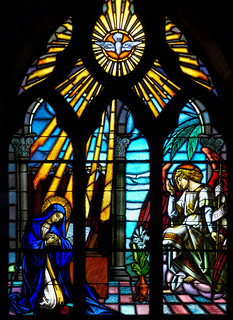
A formal architectural setting frames the moment of Gabriel’s appearance to Mary. Tiled floors and fluted columns anchor the scene, while sweeping golden rays signal divine intervention. Mary kneels in prayer as Gabriel approaches, his wings catching the same light. The clarity of the drawing and the interplay of geometry and radiance reflect Mauméjean’s confident interwar aesthetic.
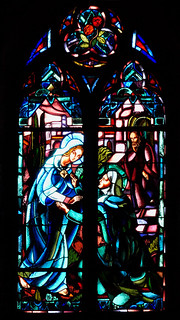
This window departs from the sharper, faceted Mauméjean idiom. Mary and Elizabeth embrace in a softly modelled scene with rounded drapery and gentler transitions of colour. The background is more painterly and less architectural than in the rest of the cycle. Although produced by the Mauméjean workshop, its distinctive style suggests it derives from an externally supplied or older cartoon. Its warmth and lyricism provide a complementary contrast within the series.
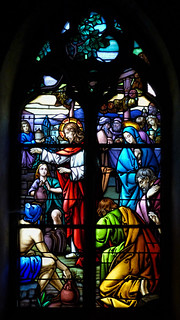
A bustling composition shows Christ transforming water into wine during the wedding feast. Figures gather around the central action, their gestures animated and expressive. Deep reds and blues dominate, and the layered grouping of attendants and vessels creates a lively, narrative focus. This window marks a shift towards denser storytelling within the cycle.
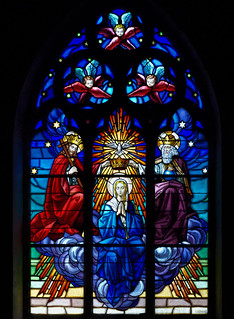
Set in a radiant heavenly realm, this window presents Mary being crowned by Christ and God the Father, with the Holy Spirit above. Clusters of angels fill the tracery lights, creating a rhythm of colour and wings. The harmony of blues and purples and the upward movement of the composition link the earthly episodes of the cycle with their celestial culmination.
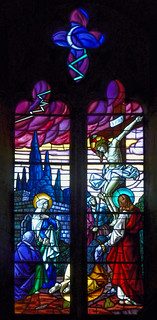
Dramatic sky colours and strongly angled drapery intensify the emotional force of this window. Christ hangs on the Cross against a backdrop of deep violet clouds, while Mary, John, and the onlookers mourn below. The geometric silhouettes of the city beyond the walls reflect the workshop’s increasingly modernist tendencies in the early 1930s.
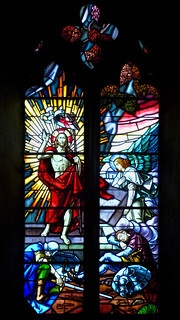
The cycle reaches its visual and emotional peak here. Christ rises from the tomb in an explosion of radiant light that fills the left lancet. Soldiers are slumped in sleep, their armour scattered in the foreground. The angel’s calm presence contrasts with the dynamic diagonals of Christ’s ascension. The boldness of colour and movement exemplifies Mauméjean’s most expressive interwar work.
Stylistic Evolution Across the Sequence (1929–1932)
The Déols cycle shows a gentle stylistic progression over four years of production.
1929–1930: Clarity and Structure
The Nativity and Annunciation establish the workshop’s late-1920s language: crisp lines, balanced architectural framing, and controlled use of radiating light. These windows are structured, luminous, and formal.
1930: A Distinctive Interruption
The Visitation diverges from this idiom. Its softer contours, gentler modelling, and rounded drapery differ from the sharper interwar Mauméjean style. The panel likely reflects a different cartoon source, a reminder of the workshop’s collaborative and adaptable practice.
1930–1931: Increasing Narrative Density
The Wedding at Cana and Coronation of the Virgin display richer storytelling and more dynamic clustering of figures. The colours deepen, and drapery becomes more expressive, preparing for the heightened drama of the later windows.
1932: Emotional and Dramatic Expansion
The Crucifixion and Resurrection show the most intense stylistic development: angular forms, dramatic skies, and powerful diagonals. The colour palette becomes more forceful, and divine light is rendered with near-explosive energy. These final windows represent the full expressive maturity of Mauméjean’s interwar glass.
